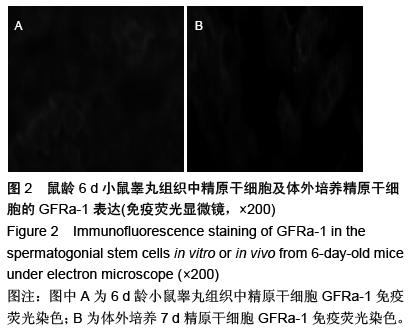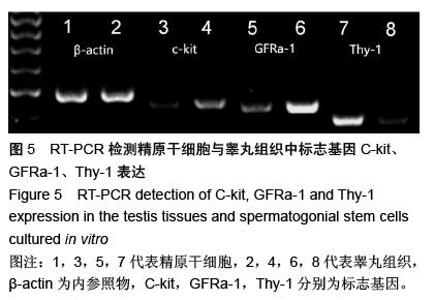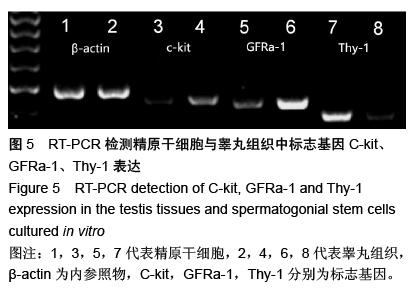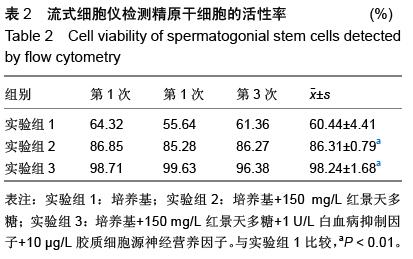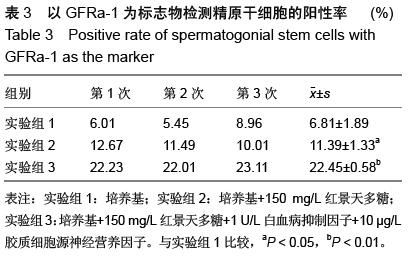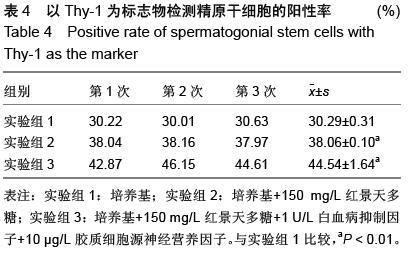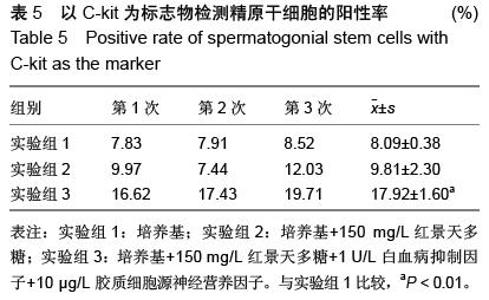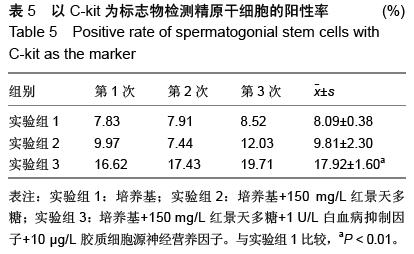| [1] Takehashi M, Kanatsu-Shinohara M, Inoue K, et al. Adenovirus-mediated gene delivery into mouse spermatogonial stem cells. Proc Natl Acad Sci U S A. 2007;104(8):2596-2601.[2] Oatley JM, Brinster RL. Spermatogonial stem cells. Methods Enzymol. 2006;419:259-282.[3] Hamra FK, Schultz N, Chapman KM, et al. Defining the spermatogonial stem cell. Dev Biol. 2004;269(2): 393-410.[4] Matzuk MM. Germ-line immortality. Proc Natl Acad Sci U S A. 2004;101(47):16395-16396.[5] Kanatsu-Shinohara M, Ogonuki N, Inoue K, et al. Restoration of fertility in infertile mice by transplantation of cryopreserved male germline stem cells. Hum Reprod. 2003;18(12):2660-2667.[6] Oatley JM, Brinster RL. Spermatogonial stem cells. Methods Enzymol. 2006;419:259-282.[7] Kai T, Spradling A. Differentiating germ cells can revert into functional stem cells in Drosophila melanogaster ovaries. Nature. 2004;428(6982):564-569.[8] 罗利攀,钟国辉,田发益,等.不同产地大花红景天多糖的单糖组成分析[J].食品与发酵工业,2013,39(4):213-215.[9] 黄冰洋,郭靖,魏海,等.红景天多糖研究进展[J].吉林医药学院学报,2012,32(2):108-111.[10] 中华人民共和国科学技术部.关于善待实验动物的指导性意见.2006-09-30.[11] 刘明成,张得钧. 红景天药理作用研究进展[J]. 亚太传统医药,2013,9(6):65-69.[12] 罗利攀,钟国辉,田发益,等.红景天多糖研究进展[J].山东林业科技,2013,1:91-95.[13] 杨斌.红景天甙对乙醛刺激的大鼠肝星状细胞Wnt信号通路的影响及其意义[D].重庆:第三军医大学,2010. [14] 王苏华,陆静尔. 红景天多糖对四氧嘧啶诱导高血糖大鼠胰腺的保护作用[J]. 中华中医药学刊,2013,31(5): 1176-1177, 1225.[15] 关爽.红景天苷的抗炎作用及其对炎症信号转导通路的调控[D].长春:吉林大学,2011.[16] Guan K, Nayernia K, Maier LS, et al. Pluripotency of spermatogonial stem cells from adult mouse testis. Nature. 2006;440(7088):1199-1203.[17] 张卫星,韩广业,王瑞,等.大鼠精原干细胞的分离纯化[J].郑州大学学报:医学版,2009,44(3):497-500.[18] Jiang FX, Short RV. Male germ cell transplantation in rats: apparent synchronization of spermatogenesis between host and donor seminiferous epithelia. Int J Androl. 1995;18(6):326-330.[19] Reding SC, Stepnoski AL, Cloninger EW, et al. THY1 is a conserved marker of undifferentiated spermatogonia in the pre-pubertal bull testis. Reproduction. 2010; 139(5):893-903.[20] Shinohara T, Avarbock MR, Brinster RL. beta1- and alpha6-integrin are surface markers on mouse spermatogonial stem cells. Proc Natl Acad Sci U S A. 1999;96(10):5504-5509. [21] Kanatsu-Shinohara M, Ogonuki N, Inoue K, et al. Long-term proliferation in culture and germline transmission of mouse male germline stem cells. Biol Reprod. 2003;69(2):612-616.[22] Izadyar F, Spierenberg GT, Creemers LB, et al. Isolation and purification of type A spermatogonia from the bovine testis. Reproduction. 2002;124(1):85-94.[23] Hofmann MC, Narisawa S, Hess RA, et al. Immortalization of germ cells and somatic testicular cells using the SV40 large T antigen. Exp Cell Res. 1992;201(2):417-435.[24] Goossens E, De Rycke M, Haentjens P, et al. DNA methylation patterns of spermatozoa and two generations of offspring obtained after murine spermatogonial stem cell transplantation. Hum Reprod. 2009;24(9):2255-2263.[25] Kanatsu-Shinohara M, Morimoto T, Toyokuni S, et al. Regulation of mouse spermatogonial stem cell self-renewing division by the pituitary gland. Biol Reprod. 2004;70(6):1731-1737.[26] Bucci LR, Meistrich ML. Effects of busulfan on murine spermatogenesis: cytotoxicity, sterility, sperm abnormalities, and dominant lethal mutations. Mutat Res. 1987;176(2):259-268.[27] Stellflug JN, Green JS, Leathers CW. Antifertility effect of busulfan and procarbazine in male and female coyotes. Biol Reprod. 1985;33(5):1237-1243.[28] Kim JH, Jung-Ha HS, Lee HT, et al. Development of a positive method for male stem cell-mediated gene transfer in mouse and pig. Mol Reprod Dev. 1997; 46(4):515-526.[29] Moisan AE, Foster RA, Betteridge KJ, et al. Dose-response of RAG2-/-/gammac-/- mice to busulfan in preparation for spermatogonial transplantation. Reproduction. 2003;126(2):205-216.[30] Kim Y, Selvaraj V, Dobrinski I, et al. Recipient preparation and mixed germ cell isolation for spermatogonial stem cell transplantation in domestic cats. J Androl. 2006;27(2):248-256.[31] Dobrinski I, Avarbock MR, Brinster RL.Transplantation of germ cells from rabbits and dogs into mouse testes. Biol Reprod. 1999;61(5):1331-1339.[32] Nagano M, McCarrey JR, Brinster RL. Primate spermatogonial stem cells colonize mouse testes. Biol Reprod. 2001;64(5):1409-1416. |



